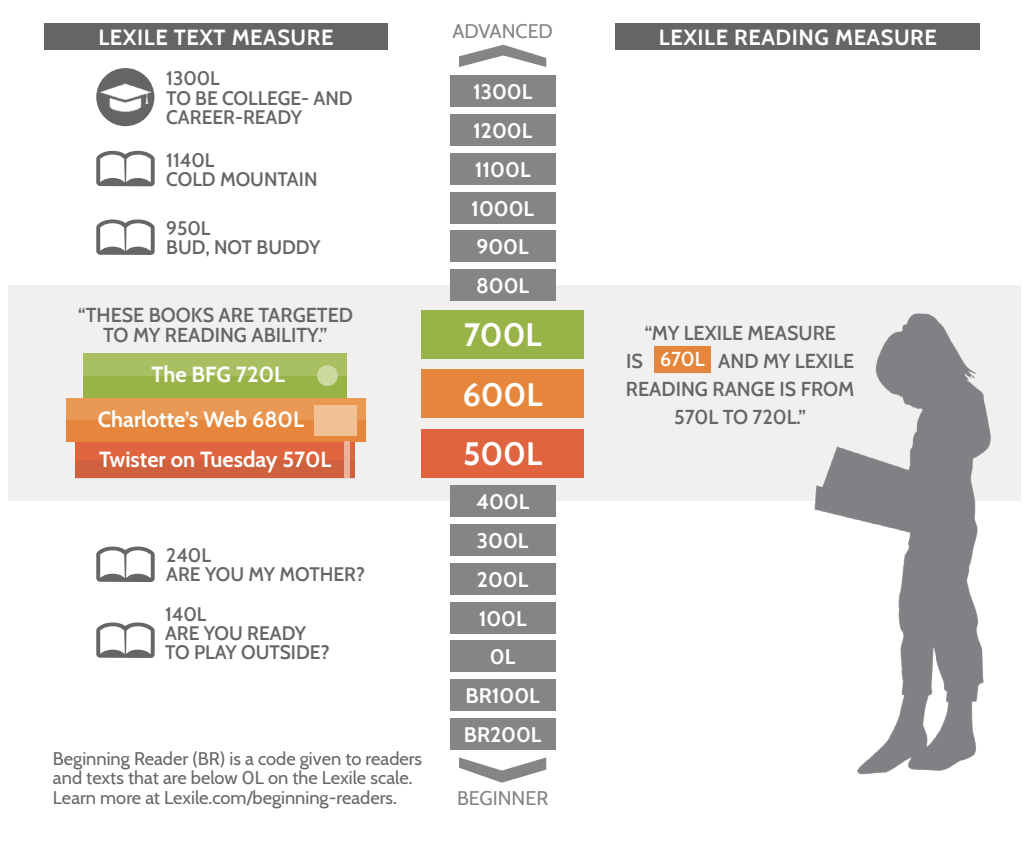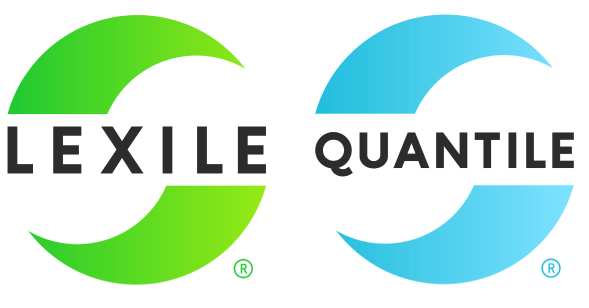Lexile Measures Parent Guide
What is the Lexile Framework for Reading?
The Lexile Framework for Reading measures your child’s reading ability and the difficulty of text, such as books and articles, on the same scale, putting a powerful tool for supporting the development of your child’s reading ability at your fingertips. More than 100 million books, articles, and websites have Lexile measures. A Lexile measure is a number followed by an “L,” such as “800L.”
How Can I Use My Child’s Lexile Measure?
Reading will open up new worlds for your child. You can match your child’s Lexile measure with a book in the comprehension “sweet spot” (100L below to 50L above your child’s reported Lexile measure) to find materials that are right for your child to read on their own.
Using Lexile measures to match them with books at their reading level sets them up for success and helps them develop a lifelong love of reading.
As a parent, you can use Lexile measures to:
- Select reading materials for your child they can comprehend with the Find a Book tool.
- Monitor your child’s progress over time with the Lexile Growth Planner tool.
- Have a conversation with your child’s teacher to identify ways to support reading growth at home.
- Help your child become a confident reader.

My Child Is Beginning to Read - How Can I Help?
Supporting the development of your child’s reading abilities from the earliest age will help put them on the path to becoming proficient, confident readers. Lexile measures support the start of that journey with our measures for beginning readers.
What is a Beginning Reader Book?
All books measuring below 0L are given a “BR” (Beginning Reader) code. In addition, texts with a BR code also receive a Lexile measure (e.g., BR100L). The addition of the Lexile measure for books below 0L allows for greater differentiation at the beginner level. The higher the number after the BR code, the less complex the text.
 Another way to think about it is that a Lexile measure of BR100L indicates that the Lexile measure is 100 units below 0L.
Another way to think about it is that a Lexile measure of BR100L indicates that the Lexile measure is 100 units below 0L.
Just like -10° is higher (warmer) than -30° on a thermometer, a BR100L book is more complex than a BR300L book. The higher the number after the BR code, the less complex the text.
How Do I Help My Child Learn How to Decode Words?
When your child learns to read, they start with putting letters and sounds together. They are learning how to “decode” words. In addition to Lexile measures, we offer some great resources that you can use to help your child begin to develop these foundational reading skills.
- Find a Decodable Book: You can search these short, online books by vowel sounds and see sound spelling percentages, spelling patterns, sight words, and more, and then practice them with your child.
- Decodable Passages: These fun, engaging passages will help your child build decoding skills. Written by published authors of decodable books, our collection of more than 100 decodable passages are categorized by sound spellings with nearly 50 passages that contain short vowels, blends, and digraphs. Each passage features an illustration and two comprehension questions.
How Can I Find Beginning Reader Books?
By reading books at their level, your beginning reader will comprehend the material and stay motivated while being introduced to new sentence structures and vocabulary.
To find books for your beginning reader, visit our Find a Book tool. You can search for books based on your child’s grade, or use the Beginning Reader (BR) code to find books that are a perfect fit for their reading level. This will help you discover books that match your child's abilities and interests, ensuring they feel confident and excited to keep reading.
How Can I Support My Child’s Reading At Home?
Help your child select books on topics they are interested in:
- If the selected book is above their Lexile measure “sweet spot,” read it together. When the selected book is below their Lexile measure “sweet spot,” help the child find what they want to read next about that topic or character(s) in a more challenging book.
- If the child finds the book does not interest them, let them know it is okay to select a different one.
Ask questions as they are reading:
- What’s your favorite character? Favorite part?
- What’s the scariest part? Funniest part?
- What are three new things you learned?
- When reading is finished, ask the child:
- Do you like how this writer tells a story or how they explain the content? Why?
- Can you retell the story? (listen for a beginning, middle, and end.)
- What else do you want to learn about this topic?
Your child will often want to read books below their Lexile measure. Encourage it!
Reading easier books is a great way to build knowledge so they can read more challenging books on the same or different topics in the future.
Encourage your child to choose books on a variety of topics and Lexile measures from a variety of genres.
- Fiction: realistic fiction, historical fiction, science fiction, fables, fantasy, fairy tales, short stories
- Non-Fiction: biographies, informational
- Poetry: rhymed
Let your child catch you reading and talk to them about it!

How do I Access Reading and Math Tools for My Child?
The Lexile & Quantile Hub features a wide variety of resources to help you support the growth of your child’s reading and math abilities.
- Lexile Find a Book can help your child build vocabulary skills. Find a Book includes a vocabulary feature that identifies up to 10 words from a book your child is reading. The vocabulary words are included along with their definitions, parts of speech and example sentences from the Oxford Dictionary. This information is a great jumping-off point for discussing the new words they are learning with your child and challenging them to use them in conversations or writing.
- Lexile WordLists features lists of key vocabulary by grade level and subject (math, science, social studies). It’s a terrific tool for vocabulary building. Print out a list of words on a topic your child is studying at school and encourage them to use them at the dinner table or in a game of Scrabble.
- Math Resources include nearly 4,000 free online activities, online games, worksheets, videos, and more to support math learning, tailored to your child's state, grade, and ability level.
- Lexile Growth Planner & Quantile Growth Planner forecast growth and explore the reading and math demands for hundreds of careers.
- Lexile Career Database & Quantile Career Database project the reading and math growth necessary for career preparedness for more than 600 careers (to date) as well as important descriptive information, such as median pay, projected career growth, and education level required for each career. Combined with the Growth planners, the Career Databases provides you with powerful tools for mapping your child’s path to success in college and career.
